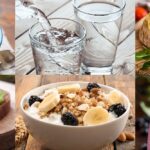Foods high in protein, like meats, poultry, fish, beans, nuts, and yogurt, increase satiety levels. Carbohydrates add bulk, contributing to satiety.
When it comes to managing cravings and promoting feelings of fullness, selecting the right foods is key. Certain foods can help curb cravings and keep you feeling satisfied for longer periods. Incorporating protein-rich options such as meats, poultry, and fish, along with fiber-filled choices like whole grains and fruits, can assist in reducing hunger pangs and promoting satiety.
Additionally, focusing on foods rich in fiber, such as peas, lentils, and whole grains, can aid in curbing cravings and promoting a sense of fullness. By making mindful choices and incorporating these satiating foods into your diet, you can better manage cravings and support your overall health and wellness goals.
The Science Of Satiety
Discover the science of satiety with foods that reduce cravings and promote fullness. Incorporate protein-rich options like meats, fish, and yogurt, along with fiber-filled carbohydrates to help curb hunger and keep you feeling satisfied longer. Embrace a balanced diet to support your satiety goals naturally.
Satiety Signals In The Body
Satiety is a feeling of fullness and satisfaction that helps to regulate food intake. When we eat, our body releases various satiety signals that help us know when to stop eating. The primary satiety signal is the hormone leptin, which is produced by fat cells and signals the brain to reduce hunger and increase energy expenditure. Other satiety signals include cholecystokinin (CCK), peptide YY (PYY), and glucagon-like peptide-1 (GLP-1), which are released by the gut in response to food intake.
Hormones And Hunger: Understanding The Connection
Hunger is a complex physiological state that is regulated by hormones, including ghrelin and insulin. Ghrelin is produced in the stomach and stimulates appetite, while insulin is produced in the pancreas and regulates blood sugar levels. When we eat, ghrelin levels decrease, and insulin levels increase, helping to reduce hunger. However, in individuals with insulin resistance or diabetes, this process may be disrupted, leading to increased hunger and cravings.
To promote satiety and reduce cravings, it’s important to choose foods that are high in protein and fiber, as these nutrients help to increase feelings of fullness and reduce hunger. Examples of protein-rich foods include meat, fish, poultry, beans, nuts, and yogurt, while fiber-rich foods include fruits, vegetables, whole grains, and legumes. Additionally, staying hydrated and getting enough sleep can also help to regulate hunger hormones and promote satiety.
Protein: A Hunger-busting Powerhouse
Best Protein Sources For Curbing Appetite
Eating foods rich in protein can help curb appetite and reduce cravings. Some of the best sources of protein for promoting satiety include:
- Lean meats such as chicken, turkey, and lean cuts of beef
- Fatty fish like salmon, trout, and sardines
- Eggs, especially when consumed with the yolk
- Dairy products such as Greek yogurt and cottage cheese
- Plant-based options like lentils, chickpeas, and quinoa
How Protein Keeps You Feeling Full
Protein has a powerful impact on promoting feelings of fullness and satisfaction. When consumed, protein triggers the release of hormones that signal fullness to the brain, reducing the desire to eat. Additionally, protein takes longer to digest compared to carbohydrates, which helps in prolonging the feeling of fullness and reducing the frequency of cravings.
Fiber-filled Foods To Fight Cravings
Fiber-Filled Foods are a powerful ally in the battle against cravings, helping you stay full longer and resist the temptation of unhealthy snacks. By incorporating fiber-rich foods into your diet, you can promote satiety and maintain a healthy eating routine.
Top Fiber-rich Foods For Satiety
- Whole grains
- Legumes
- Fruits
- Vegetables
- Nuts
The Role Of Fiber In Digestive Health And Satiety
Fiber plays a crucial role in promoting digestive health and satiety. It adds bulk to your meals, slowing down digestion and keeping you feeling full for longer periods. Additionally, fiber can ferment in the intestinal tract, producing short-chain fatty acids that enhance the feeling of fullness.
Smart Carbohydrates For Lasting Fullness
Smart carbohydrates play a crucial role in reducing cravings and promoting satiety. By choosing the right carbohydrates, you can effectively manage hunger and maintain a feeling of fullness for longer periods. Let’s explore the impact of smart carbohydrates on satiety and how they can be incorporated into a balanced diet.
Whole Grains: Your Ally In Satiety
Whole grains are a powerhouse of nutrients and are known for their ability to promote satiety. Unlike refined grains, whole grains contain the entire grain kernel, including the bran, germ, and endosperm, which are rich in fiber, vitamins, and minerals.
- Whole grains include options such as brown rice, quinoa, barley, and oats.
- These grains provide a steady release of energy, helping to curb cravings and keep hunger at bay.
- They also contribute to a feeling of fullness, making them a valuable addition to meals and snacks.
Complex Carbs Vs. Simple Sugars
It’s essential to distinguish between complex carbohydrates and simple sugars when it comes to promoting lasting fullness. Complex carbohydrates are made up of longer chains of sugar molecules, which take longer to break down and provide a sustained source of energy.
On the other hand, simple sugars, found in processed and sugary foods, are quickly digested and can lead to rapid spikes and crashes in blood sugar levels, ultimately leaving you feeling hungry soon after consumption.
Healthy Fats: Satisfying And Nutritious
Eating foods rich in healthy fats can play a crucial role in reducing cravings and promoting satiety. Healthy fats not only provide a sense of fullness but also offer essential nutrients that support overall well-being.
The Satiety Benefits Of Omega-3s
Foods rich in omega-3 fatty acids, such as fatty fish, chia seeds, and flaxseeds, have been linked to increased satiety. Omega-3s can help regulate appetite and reduce cravings, making it easier to maintain a healthy diet.
Choosing The Right Fats For Fullness
When aiming for fullness, it’s essential to opt for healthy fats that provide both satisfaction and nutritional value. Some excellent sources of healthy fats include avocados, nuts, seeds, and olive oil. These fats not only contribute to a feeling of satiety but also offer essential nutrients, such as vitamin E and omega-3 fatty acids.
Hydration And Hunger Control
Proper hydration plays a crucial role in managing hunger and controlling cravings. Dehydration can often be mistaken for hunger, leading to unnecessary calorie consumption. Staying hydrated helps regulate appetite and promotes satiety.
Drinks That Can Suppress Appetite
- Green tea: Contains catechins that may help reduce appetite.
- Black coffee: Can suppress hunger and boost metabolism.
- Vegetable juice: Low-calorie option that can make you feel full.
The Importance Of Water In Managing Cravings
Water is essential for overall health and plays a key role in managing cravings. Often, feelings of hunger are actually thirst cues in disguise. Drinking water before meals can help control portion sizes and reduce calorie intake.
Satiety-boosting Snacks And Meals
When it comes to controlling cravings and staying full, the right snacks and meals can make all the difference. By including satiety-boosting foods in your diet, you can keep hunger at bay and reduce the urge to snack on unhealthy options throughout the day. Here are some strategies for meal planning and snack ideas that promote maximum fullness.
Meal Planning For Maximum Fullness
When planning meals for maximum fullness, it’s important to focus on nutrient-dense foods that provide a steady release of energy. Incorporating a balance of protein, healthy fats, and complex carbohydrates can help prolong the feeling of fullness and satisfaction. Consider the following meal planning tips:
- Include lean protein sources such as chicken, turkey, fish, tofu, or legumes in each meal to promote satiety.
- Opt for high-fiber carbohydrates like quinoa, brown rice, sweet potatoes, and whole grain pasta to enhance feelings of fullness.
- Incorporate healthy fats from sources like avocados, nuts, seeds, and olive oil to support long-lasting satiety.
- Choose nutrient-dense, filling vegetables such as broccoli, spinach, kale, and bell peppers to bulk up your meals without adding excessive calories.
Snack Ideas To Keep Hunger At Bay
Snacking can be a valuable tool for managing hunger between meals, but it’s essential to make smart choices to support satiety. Here are some snack ideas that can help keep hunger at bay:
- Pairing a small serving of nuts or seeds with a piece of fruit can provide a satisfying combination of fiber, protein, and healthy fats.
- Enjoying a serving of Greek yogurt with a sprinkle of granola or nuts can offer a balance of protein and carbohydrates to keep you feeling full.
- Snacking on raw vegetables with hummus or guacamole can provide a crunchy, fiber-rich option to stave off hunger between meals.
- Opting for a small portion of whole grain crackers with a slice of lean turkey or a smear of nut butter can offer a satisfying blend of complex carbohydrates and protein.
By incorporating these meal planning and snack ideas into your daily routine, you can support feelings of fullness and reduce cravings, ultimately making it easier to maintain a healthy eating pattern.
The Psychology Of Eating: Cravings Explained
Explore how specific foods can help reduce cravings and promote feelings of fullness. Incorporating protein-rich options like meats, fish, and yogurt, along with high-fiber choices such as whole grains and fruits, can aid in curbing cravings and supporting satiety levels naturally.
Emotional Eating Vs. Physical Hunger
Cravings are a natural part of the human experience, but they can be difficult to manage. The first step to overcoming cravings is to understand the difference between emotional eating and physical hunger. Emotional eating is when you eat to soothe negative emotions like stress, boredom, or sadness. Physical hunger, on the other hand, is when your body needs fuel to function properly.
Strategies To Overcome Cravings
Once you understand the difference between emotional eating and physical hunger, you can begin to develop strategies to overcome cravings. Here are a few strategies to get started:
- Eat protein-rich foods: Protein helps to increase satiety levels and reduce cravings. Foods high in protein include meats, poultry, fish, beans, nuts, and yogurt.
- Choose foods high in fiber: Fiber adds bulk to your meals, which can help you feel full and satisfied. Foods high in fiber include whole grains, fruits, vegetables, and nuts.
- Stay hydrated: Sometimes we mistake thirst for hunger. Drinking plenty of water throughout the day can help you stay hydrated and reduce cravings.
- Practice mindfulness: Mindfulness can help you become more aware of your cravings and make conscious choices about what you eat. Take a few deep breaths before eating to help you tune in to your body’s signals.
- Get enough sleep: Lack of sleep can lead to increased levels of the hunger hormone ghrelin and decreased levels of the hormone leptin, which helps to regulate hunger and satiety.
By using these strategies, you can reduce your cravings and promote satiety, making it easier to maintain a healthy diet. Remember to be patient and kind to yourself as you work to overcome cravings – it takes time and practice to develop new habits.
Supplements And Herbs For Appetite Control
When it comes to managing cravings and promoting satiety, natural supplements and herbs can play a beneficial role. These options can help reduce hunger and increase the feeling of fullness, aiding in weight management and overall health.
Natural Supplements To Reduce Hunger
- Protein Powders: A convenient way to increase protein intake, promoting fullness.
- Fiber Supplements: Help increase satiety and regulate digestion.
- Omega-3 Fatty Acids: Known to reduce appetite and support brain health.
Herbal Remedies For Satiety
- Garcinia Cambogia: Believed to suppress appetite and inhibit fat production.
- Green Tea Extract: Contains compounds that may help control cravings.
- Gymnema Sylvestre: Used to reduce sugar cravings and support blood sugar levels.
Lifestyle Changes For Long-term Satiety
When it comes to achieving long-term satiety, making lifestyle changes is key. By incorporating healthy habits into your daily routine, you can effectively reduce cravings and promote feelings of fullness. Lifestyle changes not only impact your physical well-being but also play a significant role in regulating appetite and hunger cues.
Exercise’s Role In Appetite Regulation
Regular exercise not only helps in maintaining a healthy weight but also plays a crucial role in appetite regulation. Physical activity can help reduce cravings by altering the levels of hunger hormones in the body. Moreover, engaging in workouts increases the production of endorphins, which can positively affect your mood and reduce the likelihood of emotional eating.
The Impact Of Sleep On Hunger And Cravings
Quality sleep is essential for regulating hunger hormones and minimizing cravings. When you’re sleep-deprived, the body experiences an imbalance in the production of ghrelin and leptin, the hormones responsible for hunger and satiety. This imbalance can lead to increased cravings for high-calorie and high-sugar foods, making it crucial to prioritize adequate sleep for long-term satiety.
Frequently Asked Questions
Which Foods Increase Satiety?
Foods that increase satiety include protein-rich foods like meats, poultry, fish, beans, nuts, and yogurt. Additionally, foods high in carbohydrates, whole grains, fiber, and fruits can help reduce cravings and keep you feeling fuller longer.
What Foods Help Curb Cravings?
Foods that help curb cravings include protein-rich options like meats, poultry, and yogurt, as well as whole grains and fiber-filled foods.
What Food Is The Most Filling Suppresses Appetite?
Foods that are high in protein, such as meats, poultry, fish, beans, nuts, and yogurt, can increase satiety levels and suppress appetite. Carbohydrates that add bulk, such as whole grains, fruits, and vegetables, can also help keep you feeling fuller longer.
Other foods that promote satiety include soups, stews, cooked whole grains, beans, lean meats, fish, eggs, and nuts. Additionally, choosing foods that are rich in fiber can help reduce cravings and promote satiety.
What Foods Help Beat Hunger And Keep You Fuller Longer?
Foods high in protein like meats, fish, and yogurt increase satiety. Whole grains, fiber, and protein-rich foods keep you feeling fuller longer.
Conclusion
Incorporating foods that promote satiety and reduce cravings into your diet can have a significant impact on your overall well-being. By opting for protein-rich options like meats, poultry, and yogurt, along with fiber-packed choices such as whole grains and fruits, you can effectively manage hunger and maintain a healthy weight.
These simple dietary adjustments can lead to a more balanced and satisfying eating experience.



